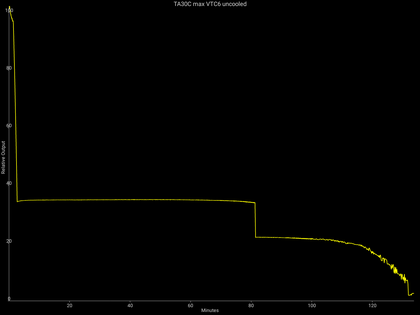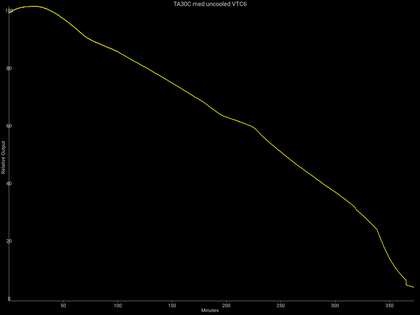This Nextorch TA30C was provided by Nextorch for review.
Overview
The Nextorch TA30C is an 18650-powered duty-style flashlight with a unique rotary control on its tailcap. It's fairly compact for the category and can be carried in a pants pocket or belt holster. Its output and throw distance are average and the build quality is quite good, but its efficiency and regulation are poor. What's most distinct is its combination of rotary switch and soft-press button.
Unfortunately for the TA30C, its efficiency of 93 lm/W can only be justified by a low price or excellent color quality; the TA30C has a high price and terrible color quality. Brightness depends on battery voltage in all modes, which is normal for budget lights, or lights with extremely high output. Neither is true of the TA30C.
The biggest issue, however is the user interface. The well-placed rotary control falls short of its potential by offering only three modes instead of the continuous dimming seen from some brands. Trying to quickly access high with the rotary control is likely to result in an overshoot to strobe. Worse the tailswitch is half-press for high and full-press for strobe, with no change in effort making it very easy to get strobe by accident. This is clearly intended to be a "tactical" feature, but the police officers I've talked to about flashlights all say what they really want is foolproof access to high.
The TA30C incorporates some interesting design concepts, but gets basic functionality wrong, delivers poor value for money, and is not recommended.
Specifications
| Spec | - |
|---|---|
| Battery | 1x18650, 2xCR123A |
| LED | Luminus SST-40 |
| Color temperature | 6022K |
| Color rendering index | 66 |
| Max lumens | 1450 |
| Max throw (meters) | 268 |
| Max sustainable lumens | n/a |
| Max lumens at 50% battery | 479 |
| Best efficiency | 93 lm/W (medium mode) |
| Candela per lumen | 12.36 (balanced) |
| Length | 135mm |
| Head diameter | 30mm |
| Weight | 97g |
| Weight with battery | 149g |
| Charging | USB-C port on included battery |
| Low Voltage Protection (LVP) | No |
| Lockout | Mechanical |
| Approximate price | $89 |
| Rating | ★★☆☆☆ (not recommended) |
Highlights
- Good build quality
- Tail rotary control is unique and ergonomic in a hammer grip
Lowlights
- Tailswitch activates strobe when trying for momentary high
- Low CRI
- Green tint
- Poor efficiency
- Output depends on battery voltage in all modes
- No low-voltage protection (unprotected batteries can be damaged)
Details and technical analysis
Versions
The TA30C only comes one way.
Accessories
The TA30C comes with a battery with USB charging port, USB cable, holder for CR123A batteries, spare O-rings, lanyard, and user manual. A MOLLE-compatible pivoting holster is available for purchase separately.
Modes and user interface
Modes
| Mode | Advertised Lumens | Estimated Lumens | Estimated throw (FL1 meters) | Candela |
|---|---|---|---|---|
| I | 20 | 18 | 28 | 203 |
| II | 330 | 232 | 105 | 2735 |
| III | 1600 | 1450 | 268 | 17921 |
User interface
A rotary ring on the tailcap has four positions: TAC (off), I, II, III, and Strobe. The tailswitch overrides these positions momentarily with a half-press being III (high) and a full-press being strobe. On releasing the button, the light returns to the setting selected with the ring.
Slightly loosening the tailcap locks out activation.
Output, runtime, and efficiency
The unique driver design made measuring current impossible.
| Mode | Estimated lumens | Minutes to 80% | Minutes to 50% | Minutes to 10% | Efficiency (lm/W) |
|---|---|---|---|---|---|
| II | 232 | 131 | 256 | 359 | 93 |
| III | 1450 | 1.84 | 2.44 | 127 | 91 |
Light quality
Readings are taken from the center spot diffused with DC Fix diffusion film using an X-rite i1Pro spectrophotometer.
| Mode | Color Temperature | Tint Duv | CRI | CRI R9 (deep red) | CRI R12 (deep blue) |
|---|---|---|---|---|---|
| I | 5728K | 0.0111 (extremely green) | 66.2 | -61.7 | 34.0 |
| II | 6022K | 0.0101 (extremely green) | 66.1 | -55.4 | 36.7 |
| III | 6351K | 0.0039 (moderately green) | 66.4 | -43.0 | 40.4 |
DuV values greater than +/- 0.006 are not considered white light by ANSI. Both of the lower modes are outside this range.
There is fast PWM (flicker); it is not visible to the naked eye, but may cause scanlines in photos or video.
Beamshots
I've started using camera settings for white wall beamshots that should be comparable to Zeroair's. They are: f/4, 1/13s, 200 ISO.
Tint vs BLF 348
Tint vs Zebralight SC64c LE
The crenelations on the bezel cut into the beam significantly.
Batteries and charging
A 2600 mAh 18650 battery with a USB-C port is included. 2600 mAh is very low capacity for an 18650 with most competitors offering 3500 mAh in lights with typical power requirements at higher price points.
Unprotected, flat-top 18650s do not make contact with the springs, but do work when a spacer is used. There is no low-voltage protection; the light will eventually turn off around 2.5V because the driver stops functioning correctly, but this may not completely stop battery drain. Over-discharging an unprotected 18650 damages it, and there is a risk of fire or explosion if it is charged again.
Build
The TA30C apears well-machined. Threads are square-cut and smooth. Anodizing looks nice, but did chip easily when I dropped the tailcap. All of the corners are very rounded, suggesting Nextorch put above-average effort into machining.
Ergonomics are a strong point for the TA30C with one glaring exception. There's a matte finish that provides good grip, the rotary ring is easy to find and easy to turn. The tailswitch is proud and very easy to press under stress. The rounded surfaces make it more comfortable to pocket carry than the 30mm head diameter might suggest.
The problem, of course is that any attempt to quickly access high will almost certainly result in strobe instead.
Modification potential
The bezel is easily unscrewed to access the reflector and LED, allowing for swaps. Unfortunately, what would benefit the TA30C most is a different driver, but the tail-mounted driver is not easily replaced.





















Comments
You can use your Mastodon or Lemmy account to reply to this
Reply Reply
Reply
Loading...